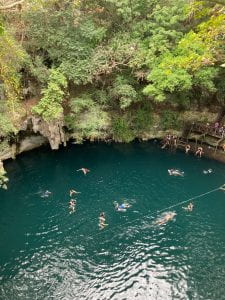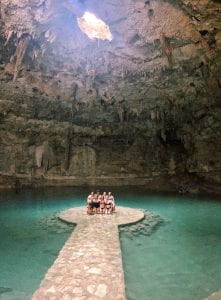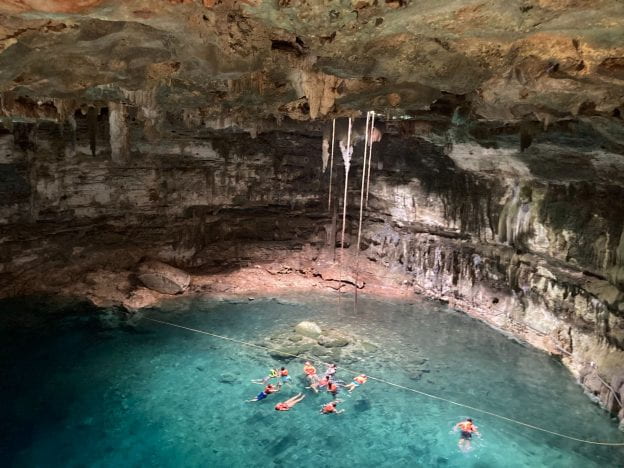As I scrolled through Instagram pictures of my friends shivering through their multi-layered down puffer jackets in front of European monarchical buildings I beamed at the brilliant blue cenote shimmering in front of me. While my friends studying abroad in Europe were spending thirty US dollars for an (admittedly top-notch) plate of fettuccine alfredo and a glass of wine (legal drinking age of 18 whoop whoop!) I spent the same amount to get escorted to no less than three cenotes, enjoyed a wonderful taco lunch and the best cream ice cream I had ever tasted. Suffice to say, I was very content with my choice of study abroad locations.
Cenotes (say-NOTE-teh) – derived from the Mayan word ts’onot – are natural holes/craters in the earth’s surface that have filled with groundwater. For many Mayan nations, cenotes served as the main source of water for thousands of years. Cenotes vary in depth and size, many reaching as far as 350 feet deep. They are one of the main tourist attractions of the area – and for a good reason – it is estimated that nearly 90% of the world’s cenotes are located in the state of Yucatán, Mexico. Though I do not understand the specific geology of cenote formation, the conditions for formation were made possible by the meteor that wiped out the dinosaurs and is hypothesized to have landed right around Mérida. As I understand it, the meteor was so powerful that when it collided with the earth’s surface it created a ripple effect much like that of a rock thrown into a pond. This created conditions in which cenotes would form in nearly a perfect circle around the Yucatanian peninsula – where I was lucky enough to be able to spend my semester.
I had high expectations for the cenotes. I absolutely love to swim – especially in lakes and ponds and other natural bodies of water – and the pictures that I had spent slightly-too-long googling of cenotes were truly breathtaking. All that being said, nothing could prepare me for the lived experience of diving into the transparent, infinitely deep water surrounded by shimmering stalactites.
The first cenote I visited is located near Chichen Itza, a world-renowned Mayan archeological site. Yokdzonot is an open air cenote estimated to be at least 100 feet deep. It’s too deep to see the bottom, but the water is so clean and clear that you can follow a sinking object with your eyes for minutes. Due to scientific reasons which I do not understand, the water is bioluminescent, so as you paddle throughout the little hollowed caverns around the edge of the cenote, a blue glow illuminates your skin and the faces of all those around you. It truly felt magical.

Open-air Yokdzonot cenote located near Chichen Itza
A weekend later a few friends and I traveled to the neighboring town of Valladolid, a touristy colonial city about two hours outside of Mérida known for its proximity to many world-renowned cenotes. In Valladolid I explored my first ever underground cenote and the experience was astonishing. All the cenotes we visited are closely monitored and set up for visitors from around the world. Each cenote was entered by descending a steep and narrow stone staircase that eventually opened up to a massive cavern covered in stalactites and the gleaming cenote in the middle. Many also had a small hole in the top through which sunlight streamed through creating a semi-celestial image.

Suyten cenote in Valladolid
I could spend hours describing the otherworldly beauty of cenotes I have explored and those I hope to visit, but for your sake and mine I am going to wrap it up here. I will be sure to keep you all updated on my other adventures water-related and not during my remaining four months. Thanks for reading, I’m sending you all some sunny warmth from Mérida. ¡Nos vemos más tarde!
